專欄
慢慢作畫 好好生活-版畫藝術家・李屏宜
慢慢作畫 好好生活-版畫藝術家・李屏宜
Print Slowly and Live Happily Print Artist -Ping-yi Li
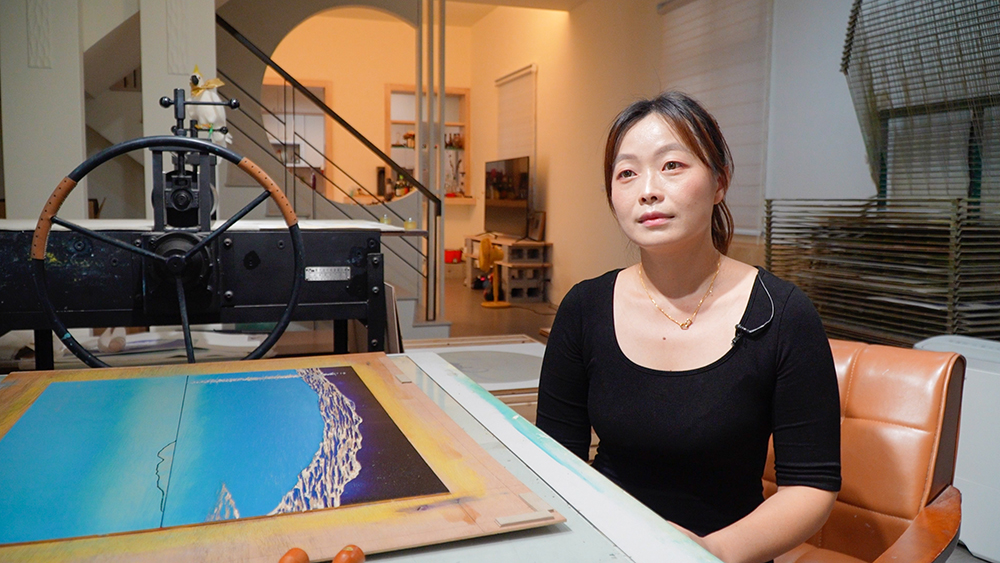
鮮豔飽和而和諧共存的色彩,烘托出既寫實又奇幻的韻味,偶有衝突的美感,偶爾又寧靜得令人發呆。版畫藝術家-李屏宜的畫作,擁有這般獨樹一幟的魅力,像是不具名的邀請,帶領大家細細品味畫作中豐富的細節。在木香充斥的工作室內,屏宜溫柔地述說起她與版畫的淵源:「小時候讀美術班,大學也就讀美術學系,過程中陸續接觸許多創作媒材,是直到大三時,才確定了自己對版畫的偏愛,並考取了北藝大美術研究所的版畫組,以期深化自己在版畫方面的鑽研。時至今日,我從事版畫創作已經十二年。」至於為什麼在眾多媒材中,選擇了版畫?屏宜不假思索的答道:「大多數的創作媒材,例如水彩、素描、油畫,都是直接繪畫,但版畫則不同,必須先有草圖、再刻出來,最後才是上色。或許比起來繁瑣很多,但卻能在過程中,發覺許多意想不到的驚喜,例如色彩的堆疊、壓印的力道、木板的紋理等,都會影響最後的作品樣貌。這是版畫獨有的特性,也是我選擇版畫的原因。」
Vibrant, saturated yet harmonious colors, which brings out the charm of both realism and fantasy. Sometimes it exudes a conflicting aesthetic, and at times it is deeply serene. Print artist - Ping-yi Li's paintings have such a unique charm, like an anonymous invitation, leading everyone to savor the rich details in the paintings. Sitting down in the studio, Ping-yi gently described her origins with printmaking, “When I was a child, I studied in art classes, and I also majored in art in college. I have been exposed to many creation methods in the process. It was not until the junior year of college that I determined my unique preference for printmaking. Then, I was admitted to graduate school to deepen my study in printmaking. And now, I have been doing printmaking for almost twelve years.” And why did she choose printmaking among so many creation methods? Ping-yi replied without hesitation, “Most creative methods, such as sketching, watercolor or oil painting, are drawn directly on the medium, but printmaking is different, you must first sketch, then engrave, and finally color. It may be tedious, but in the process, you can find many unexpected surprises, such as the stacking of colors, the strength of embossing, the texture of wood panels, etc., which will affect the appearance of the final work. This is a unique feature of printmaking, and also why I choose printmaking.”
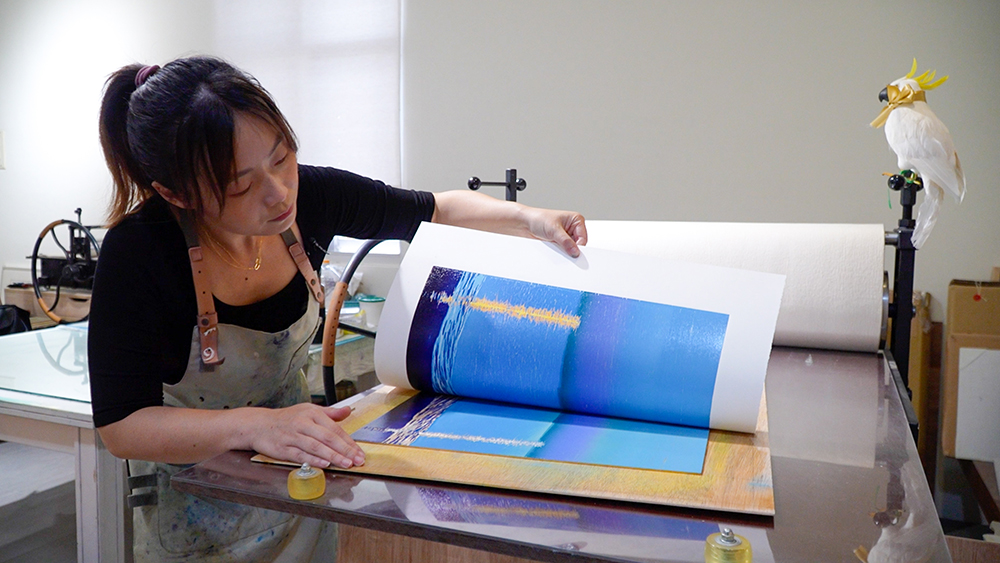
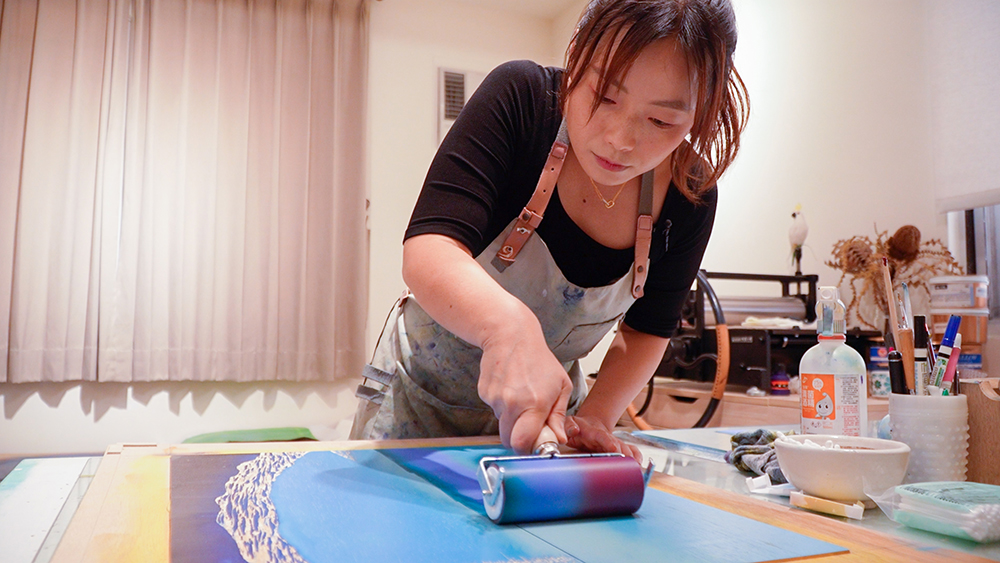
正因為版畫創作的繁瑣工序,使得大眾對於版畫較為陌生,屏宜介紹道:「版畫分為很多種類,如果以印刷原理劃分的話,可分成凸版畫、凹版畫、平版畫及孔版畫,而若以板子媒介區分的話,則分為木版畫、銅版畫、石版畫、絲網版畫及數位版畫等類型。」並接著描述:「我創作的是凸版畫中的木版畫,且主要採用單版複刻的方式,故又被稱為絕版版畫。為什麼是絕版?因為我每印一個顏色,就要刻掉一層,它是無法回溯的作畫過程,跟其他能無限複印的版畫不同。除此之外,它也更凸顯出版畫的特性,是直接繪畫的反向操作,在創作當下,要思考的不是要添加什麼,而是要保留什麼。」除了創作邏輯的顛倒,屏宜在色彩的運用上,也翻轉了過往的常態:「大多數版畫創作,會從較淺的顏色開始印,最後才印最深的顏色,畫作會給人沉穩的感覺,但我會比較喜歡從深色開始印,並在過程中慢慢加入白色,最後呈現出漸層的效果及粉嫩的色系,給人更加輕盈夢幻的感覺。」
Because of the tedious process of printmaking, most people are unfamiliar with it. Ping-yi introduced, “There are many types of prints. If it is distinguished by the printing principle, it can be divided into letterpress, gravure, and if it is distinguished by board medium, it can be divided into woodblock prints, copper prints, lithographs, silkscreen prints and digital prints.” She went on to describe, “"My creations are woodblock prints in letterpress, and I mainly use the method of reductive cutting, so they are also called out-of-print prints. Why is it out of print? Because every time I print a color, I have to engrave a layer. It is a painting process that cannot be traced back, which is different from other prints that can be copied indefinitely. In addition, it also highlights the unique characteristics of printmaking. It is the reverse operation of painting. In the moment of creation, what I have to think about is not what to add, but what to keep.” In addition to the reversal of creation logic, Ping-yi has also reversed the normal in the use of color. “Most printmaking starts with lighter colors and ends with the darkest color, which brings a sense of stability, but I prefer to start with a dark color and slowly add white in the process, showing a gradation effect and a soft color scheme, which creates a more light and dreamy feeling. ”
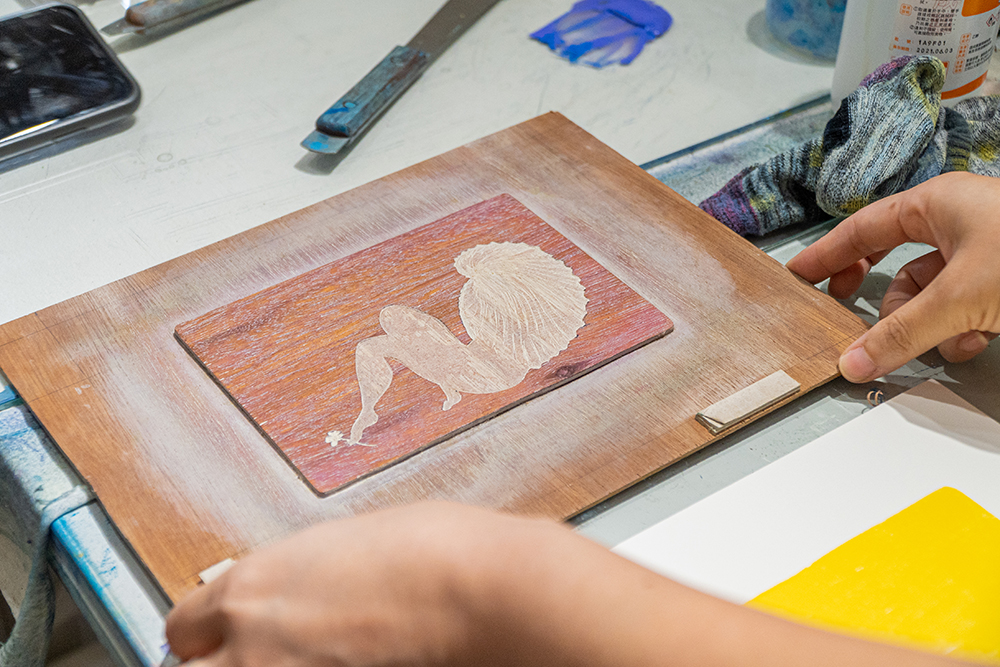
十二年的光陰,投注入版畫創作,因此不難在畫作中,看見屏宜的人生軌跡:「我的畫作,依照不同階段而有不同風貌。早期,我主要的創作內容以『嫁接』為核心,記憶結合夢境,將過往養過動物、種植過的植物,與一些夢裡非生命的物質進行結合,創造出超現實的場景。中期,我創作了貝殼少女系列,表面上依然是嫁接的概念,但其實我開始將自己的形象投射在了畫作上,利用自身探索『隱藏』與『裸露』的界線。到了現在,以我到池上駐村為起點,開始了我從未想過的創作主題-風景。我在台東生活一段時間了,過去總是將風景視為理所當然,直到至其他縣市旅遊,才明白這片美景多麼可貴。台東的山、海、天空的顏色,是難以複製的,所以我想將這塊土地的漂亮記錄下來,並把這系列作品命名為『呼吸風景』,以我的出生地-花蓮及我的現居地-台東之氛圍作為創作理念,期望透過我擅長的色彩運用,讓人從視覺就能呼吸到這份寧靜的氣息。」從生活的周遭,回歸到自身,再著眼於土地。生活,總是藝術創作最豐饒的養分。
Ping-yi has invested twelve years in printmaking, so it is not difficult to see her life trajectory in the paintings, “At different stages, my paintings show different styles. In the early days, the core of my creation was ‘grafting’, combining the animals and plants that I had raised in the past with some non-living substances in my dreams to create surreal scenes. In the mid-term, I created the Shell Girl series. On the surface, it was still the concept of ‘grafting’, but in fact, I began to project my own image on the painting to explore the boundary between ‘hidden’ and ‘nudity’. Up to now, starting from my Art-in-Residence plan in Chi-shang, I started a creative theme that I never thought of - landscape. I have lived in Taitung for a while, and I used to take the scenery for granted. It was not until I traveled to other places that I realized how precious this beauty is. The colors of the mountains, sea and sky in Taitung are difficult to replicate, so I want to record the beauty of this land and name this series ‘Breathing Landscape’. Taking the atmosphere of my birthplace - Hualien and my residence - Taitung as the creation concept, I hope that through the colors of my paintings, people could breathe this tranquil atmosphere from the sight.” The scope of Ping-yi's creation has changed from the surroundings of her life, returning back to herself, to seeing the land under her feets. Life is always the most fertile nutrient for artistic creation.
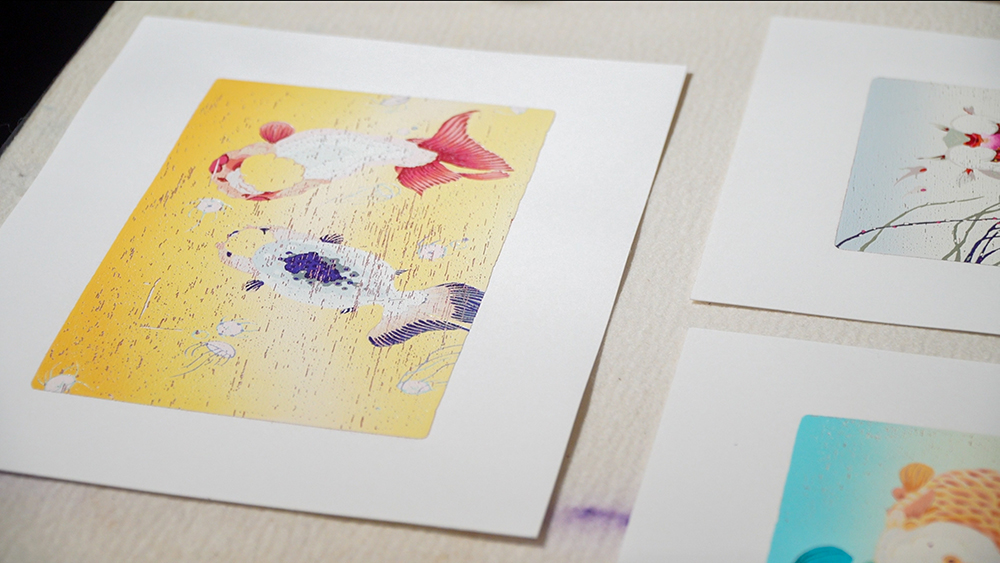
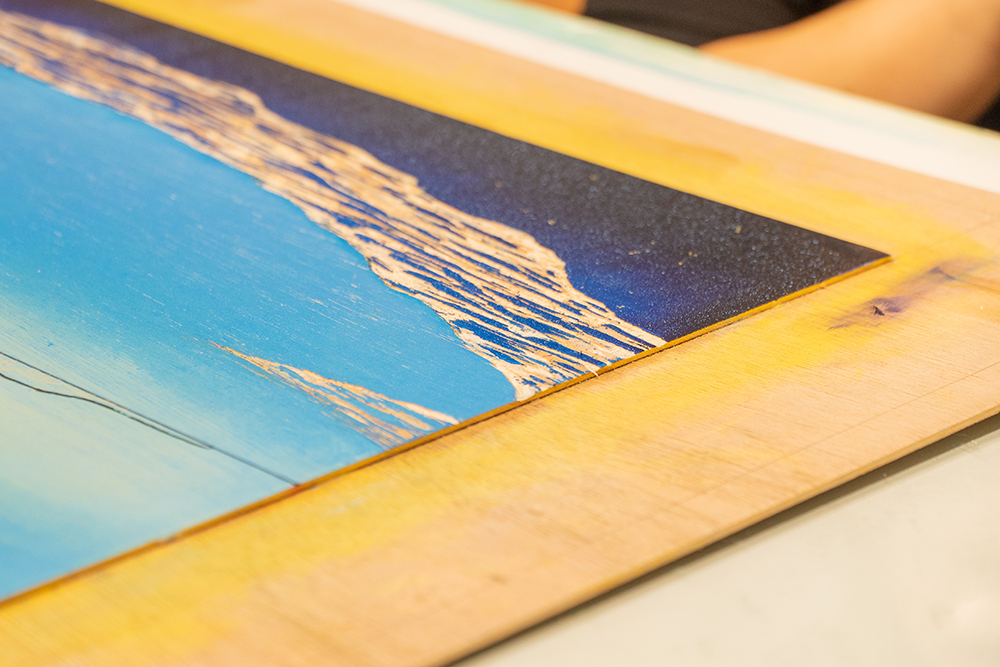
值得一提的是,屏宜近年的作品榮獲高雄獎首獎的肯定,是十幾年來第一位以版畫創作媒材獲得首獎的藝術家。問及未來的規劃,屏宜表示:「最近都在準備明年三月在台北的個展,屆時會以花東風景為主軸。」並接著說道:「為了讓人感受到風景裡的寧靜,我採用並置的手法,讓視覺上產生鏡像延伸感,並跳脫版畫既定的框架,讓板子也成為作品的一部分。因此,創作時思考的面向變得更多,而風景擁有的大片色塊,也讓我需要更精細地拿捏色彩比例。對我來說是全新的挑戰!」至於未來的期許,屏宜笑得爽朗答道:「我是一個生活節奏很慢的人,創作節奏當然也不快,而我想這就是為什麼我住在慢活的台東,並選擇只能慢慢堆疊的版畫吧!所以我對自己的期許很平實,希望在工作、生活與創作之間達到平衡,繼續好好生活。」
It is worth mentioning that Ping-yi's recent works won the first prize of Kaohsiung Award, and she is the first artist to win the first prize with the medium of printmaking in more than ten years. When asked about future plans, Ping-yi said, “I'm currently preparing for a solo exhibition in Taipei next March, which will focus on landscape.” and went on to say, “In order to make people feel the tranquility in the landscape, I use the juxtaposition method to create a sense of mirror image extension visually, and to break away from the frame of the printmaking, so that the board also becomes a part of the work. Therefore, there are more aspects to think about when creating, and the large blocks of the landscape also require me to fine-tune the colors. This is a whole new challenge for me!” As for future expectations, Ping-yi answered with a hearty smile, “I am a person with a slow pace of life, and of course the pace of creation is also slow, and I think this is why I live in Taitung, where the pace is slow, and choose prints that can only be stacked slowly. So my expectations are very modest. I hope to achieve a balance between work, life and creation, and continue to live a good life.”

Breathe-山 與 Breathe-海 (圖片來源:高雄市立美術館)
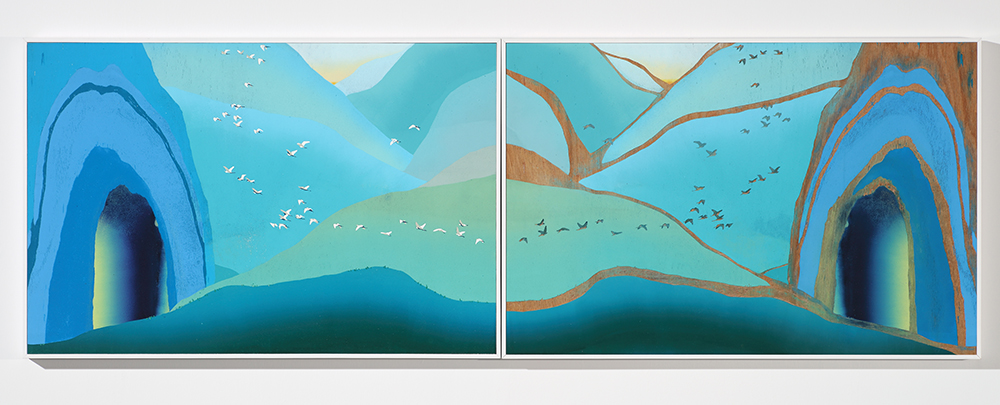
Mountains- 巒 (圖片來源:高雄市立美術館)
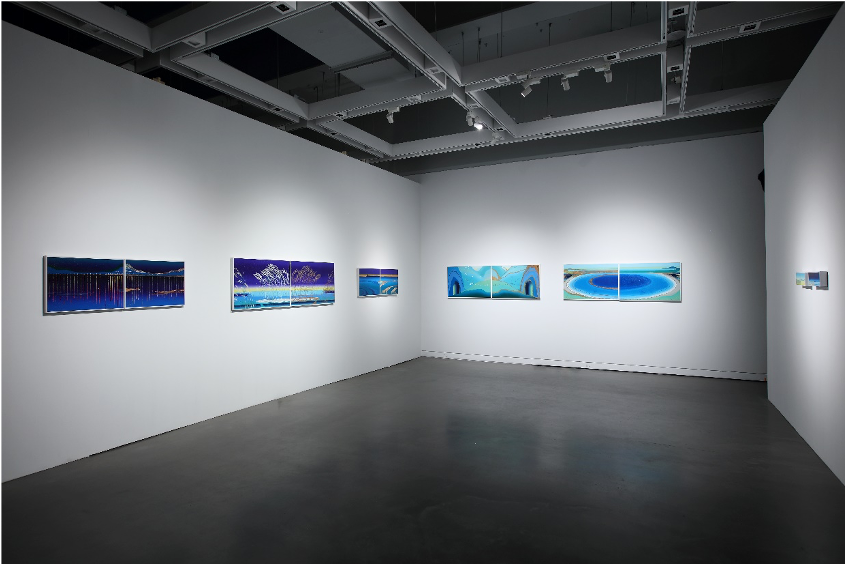
(圖片來源:高雄市立美術館)